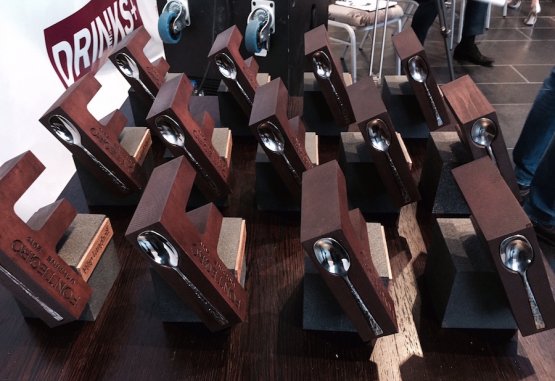Being used to the lights and glitter of the Western restaurant scene, spending three days in Kiev, the capital of tormented Ukraine, can only do good to the great Italian and European chefs and restaurateurs, but also to those from Hong Kong, Tokyo and Singapore as well as New York, Chicago and California. The opportunity was given early in February by the second edition of Fontegro, the culinary congress organised by Ekaterina Avdeyeva and Anna Zelenokhat in the Olympic stadium where Dinamo Kiev, a football legend, plays.
The stage was set in one room, with six lectures on the first day and as many on the second, while in another, larger and beautiful room there were twelve exhibitors. These numbers, taken without context may almost seem laughable (in 2005 Identità debuted with 18 speakers, which became 30 the next year), but everything in these years in Ukraine is terribly difficult and hindered by Russian pressure, the enemy outside and inside the home. The organisers need to face an infinite quantity of problems. Just think that there were no exhibitors when it debuted. From zero to twelve is already a nice step forward.

As for the foreign chefs, having them involved is extremely expensive and every invitation needs to be well considered. One extra plane ticket and there’s no budget left.
Ekaterina and
Anna gave life to
Fontegro so that it could set an example and incite Ukrainian chefs to improve even though the first not to understand are restaurateurs who are only interested in the present moment. It is very rare to find patron-chefs. Journalist
Marina Mayevska proudly wrote the same thing: “Before, we could only look at
Madrid Fusion and
Identità Golose. Today we have our own event too”. This is the same motivation that urged
Claudio Ceroni and I to create
Identità.
However, we were surrounded by great talents so much so we had the opposite problem than my colleagues in Eastern Europe. We had too much, they had too little. Last year, only one Ukrainian chef went on stage,
Yuriy Priemskii. This year the same occurred, only
Denis Komarenko, chef at
Tarelka Gastrocafè, a true passion for bread. However, he didn’t present any flavours or skills from his homeland, but from our own, from Italy. “As a chef, he has never cooked Ukrainian food”,
Mayevska reminded me, though happy nonetheless that her fellow countryman had broken the ice and was invited.
The Italian squad, with
Cristina Bowerman,
Lisa Casali,
Davide Scabin and
Franco Aliberti, to which we must add Slovenian
Ana Ros whose restaurant is in Caporetto, only a handful of kilometres from the border with Friuli, opened their eyes wide when
Komarenko got on the stage with various Italian-looking cold cuts, cooked ham but also lard presented as coming from Colonnata or even culatello since everything was the result of a course held at
Massimo Spigaroli’s
Antica Corte Pallavicina in Polesine Parmense.
It was the triumph of the Italian sounding, of fake Italian products while in one of the stands there was an exceptional selection of Ukrainian pancetta and salami. Except they have a smaller appeal on some people, in a town like Kiev where Italian restaurants are a hit in many aspects. And with the crisis due to the violent confrontation with
Putin’s Russia, original products are too expensive so more and more restaurateurs cook Italian food with local raw materials. Nothing against those who learn from us, as long as they then distinguish their cold cuts from the original one.
Aside from the Italians, Flemish
Kobe Desramaults, American
Mark Bitterman, who knows all about salt, and Turkish
Maksut Askar also stood out. The others had less drive for us westerners. Fontegro wants to showcase the different restaurant offer from Eastern Europe and this also explains some choices made for the evening meals. On the first night, we all went to
Kupecheskiy dvor, next to a forest just outside Kiev. Everything was very typical, but also very dated and of little interest except for the excellent Borsh with duck and smoked beetroot, sour cream and pancetta.
Instead, I would immediately go back to
Shoti, an imposing and beautiful place on various floors, all made in wood, a real cradle for Georgian culinary culture, something the Ukrainians adore though of course they don’t feel it as their own. Starting from the bread, a sort of
ciabatta, and in front of a cream of aubergines, you could already tell the cuisine was powerful, a declaration of seriousness and attention to every element composing a dinner. Next door, same owners, there’s
Napule. They have pizzas, but when serving a white pizza with cheese, a sort of not very stringy
scamorza, they presented it as a typical Georgian recipe as the melted cheese, which had already been served in a small pot recalling a raclette from Valais, also belongs to their culture.
Fontegro? Yes, please.